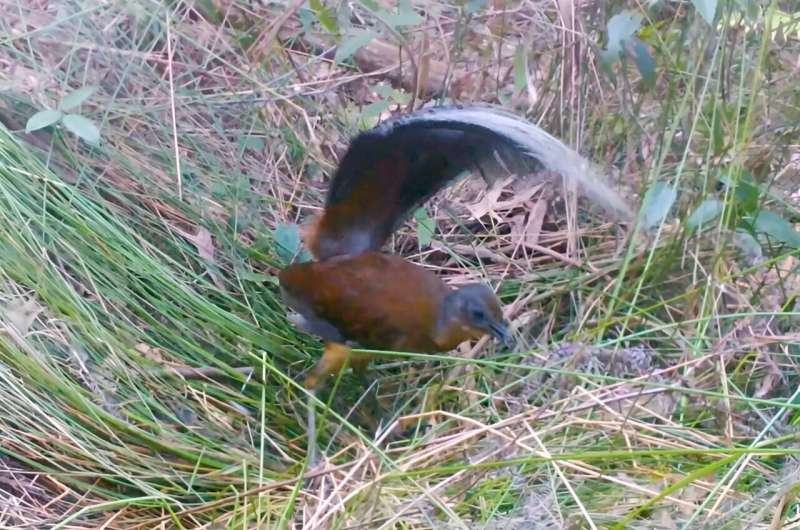This article has been reviewed according to Science X's editorial process and policies. Editors have highlighted the following attributes while ensuring the content's credibility:
fact-checked
peer-reviewed publication
trusted source
proofread
The lyrebird synchronizes elements of its mating dance

To woo a mate, the Albert's lyrebird of Australia first chooses a stage of entangled vines, then in performance he shakes the vines as part of his courtship footwork, synchronizing each shake with the beat of his striking song, according to new research.
"It's a choreographed dance," said Fiona Backhouse, a postdoctoral researcher with the Cornell Lab of Ornithology and lead author of "Performative Manipulation of the Environment by Displaying Albert's Lyrebirds," which was published March 21 in The American Naturalist and closely analyzes and quantitatively describes this lyrebird behavior.
"The birds use thorny vines tangled with other plants as a stage-like courtship platform," Backhouse said. "Then they grip the vines with their feet and bounce or sway from side to side, which makes the entire tangled mass of plant growth also move around. They combine this movement with two types of songs."
The dance includes loud and rhythmic noises. Analysis shows the lyrebird's footwork is synchronized with the beat of the rhythmic song. The lyrebird's tail is also flipped over its head during the courtship display.
Researchers captured the behavior with remote cameras placed among five populations of Albert's lyrebirds during the May 2018 through August 2019 breeding season. This range-restricted species lives in the now fragmented rainforest habitats scattered across a small mountainous region in Australia.
"Albert's lyrebirds are actually moving the structure while they're singing so it becomes an active part of their performance," Backhouse said. "I think what surprised me is that the vine-shaking behavior was so consistent across all individuals and populations, so it seems to be a species-wide trait."
There can be some variation. Instead of using vines, birds may manipulate a pile of sticks, but will always grip part of their stage with their feet and move up and down, so the behavior persists even on different platform structures.
"One possibility for why they do this vine-shaking is that it enhances their display, making the male look bigger and more vigorous by creating an impressive spectacle for a watching female," Backhouse said. "Another possibility is that by moving the vines and shaking the surrounding vegetation they're making it seem like there are predators nearby and the female may be more inclined to stay close by the performing male for safety."
During this study, no female birds were present to witness the males' efforts. Backhouse hopes to collect more footage next year, documenting what happens when female birds are watching and whether that changes the performance in any way.
More information: Fiona Backhouse et al, Performative manipulation of the environment by displaying Albert's lyrebirds, The American Naturalist (2024). DOI: 10.1086/730523
Journal information: American Naturalist
Provided by Cornell University




















